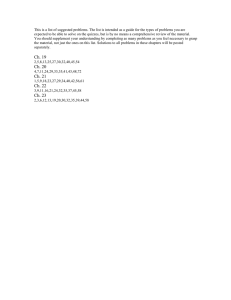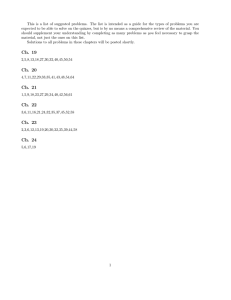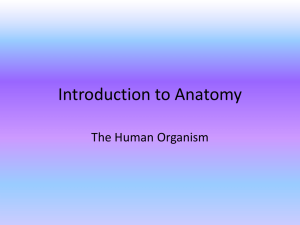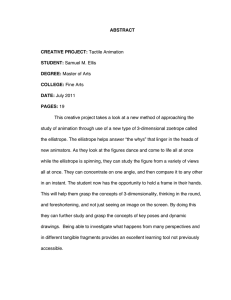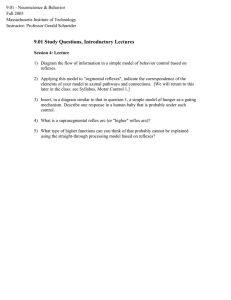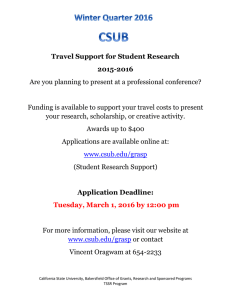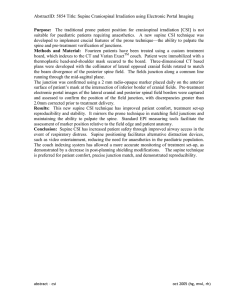Evaluation in pediatric
advertisement
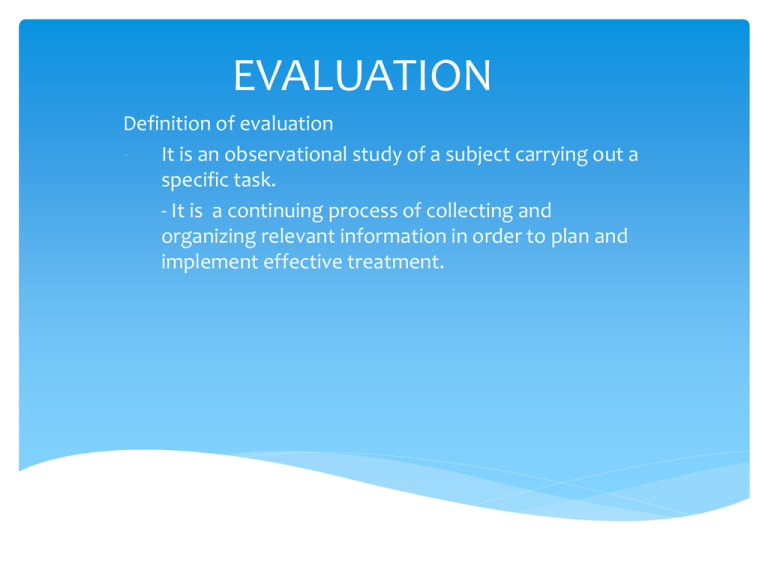
EVALUATION Definition of evaluation It is an observational study of a subject carrying out a specific task. - It is a continuing process of collecting and organizing relevant information in order to plan and implement effective treatment. Importance of Evaluation 1- To plan a treatment program, 2- To identify area of progress or lack of progress. 3- To identify or rule out the existance of a specific problem. 4-To provide diagnostic information 5- setting up a good relationship with the child to understand their difficulties and needs. 6- To determine the the status of a patient at the time of discharge and type of follow up plan. Pre-requisites of Evaluation 1- Knowledge; human biological , behavioural, motor development and sequence of reflexive maturation in normal children. 2- Rational and logical system of data acquisition complete picture of the client is developed through analysis and synthesis of data. 3-organized observation Problem that may occur during evaluation 1- The assessment form: Follow The SOAP note by Dr. Lowerance Weed 2- Interaction with the child Using toy , Reward, Toy 3- Response of parents to evaluation results Home program, no false hope principles of Evaluation 1- the evaluation should focus on the client abilities as well as disabilities. 2- The evaluation should be carried out as early as possible. 3- The evaluation should be accomplished in a sequential fashion in order to monitor the development course of reflexes and reaction. 4 Re evaluation takes place on a weekly or monthly basis. 5-Therapist should have the ability to observe, to be flexible to be creative. 6-oreintation of the child and parent to the enviroment is crucial Types of Evaluation 1- Informal (general overview of the child performance). 2- Formal (functional test) 3- Standardized: grading performance (muscle test: Initial evaluation interim or progress discharge evaluation Problem oriented medical Record It is a designed a plan for collecting data and organized them by problems thus assuring logical frame work for delivery of health care It is not only a tool for planningg care but also a teaching tool and used for review of care to ensure quality of patient care. Importance of POMR 1- It is legal document and assist in treatment. 2- It is a methods of communication between physician and therapist 3- it helps in thinking in organized manner. 4- it puts all clinical information in the way that you can share it with others 5- it used for quality assurance purposes 6- it can be used in research Advantages of POMR 1-Information of clinical, laboratory and therapy. 2- Information about past illness 3- facilitate continuity of care. 4- Assist in evaluation and planning of health care system 5- Used in clinical research and medical education Elements of POMR 1- Data base 3- Initial plan 2- Problem list 4- progress notes Data base consists of all subjective and objective in formation can be collected from the patient Sources of data base 1- patient file 2- questioning 3- patient evaluation(Observation, palpation, measurements and functional tests 2- Problem list: All patient problems should be constructed from the data base. Each problem should be classified whether it is active ( not been solved) or inactive treated temporarily or permanently Date of the initial start of the problem and date of solving the problem should be recorded. 3- initial plan : what will be done to begin solving the problem. Specific plan for each active problem It should be realistic and aiming for solving the problem 4- Progress notes These consist of a record of patient care and progress commonly written under 4 headings SOAP S --------- subjective O ------------Objective A---------------Assesment P -----------------Plan NORMAL MOTOR DEVELOPMENT SENSORY AND MOTOR DEVELOPMENT Sensory and motor development are independent Sensation not only provide inputs from the environment but also create awareness on our bodies, and feedback on variety of movement that occur Early child movement and posture that occur as stereotyped reflexes provide a foundation for voluntary movement Movements become more integrated and selective as the child has the ability to perform the isolated movements The neonate (Birth till 4 weeks) The neonate movements are determined by reflexes In most position his body is flexed except for his neck but periodically he totally extends when he stretches or when he held upright with his feet on supporting surface Neonatal reflexes can be succeefully observed when the neonate is comfortable and alert. Rooting reflex and suckling reflexes: If the corner of the mouth or check is touched, neonate will turn his face towards the stimulus The rooting reflex orients the body mouth to mother nipple Moro reflex: it occurs when the baby head suddenly falls backwards, The arm immediately abduct with extended elbows , wrist and fingers . The reflex disappears at the age 6 months Galant reflex It can be elicted by pricking on the paravertebral area of the back from the bottom rib to the iliac crest the trunk flex sideway towards the stimulus disappear by 2 months Crossed extension reflex When the nfant in supine With stimulating sole of the foot the contralateral limb will flex then extend with adduction and internally rotation Flexor withdrawal reflex: Stimulate the sole of the foot ---------------the leg quickly flexed Extensor thrust The leg will extend if you put a pressure on the sole of flexed leg Crossed extension, flexor withdrawal, extensor trust remain for 1-2 months before integration Plantar grasp: If you put a pressure on the ball of the foot the toes will flex remains till age of 9 months Grasp reflex when a finger is inserted into the plam of the hand of the child followed by traction to the fingers ------------strong total flexion of child arm and fingers GROSS MOTOR DEVELOPMENT A dynamic posture is essenital frame work for gross motor activities Dynamic posture requires normal posture reflex mechanisms with normal postural tone ----- stability and flexiability to allow for postural changes. Normal motor development Supine 1 Month Flexion pattern No head control Tonic neck reflex Fisted hand Rolling to side as a block 3 Month: Head approach to midline Pronated forearm Loosely closed hand stronger fifth finger 4 Month: Tonic neck reflex Head in midline Start exploration of the hand Alternated flexion and extension of fingers 6 Month: Rolling from supine to prone Lifting of the head lifting of the leg high 7 Month: Symmetrical supine position 10 Month Less tolerated supine sitting up Lift head as towards sitting Prone 1 Month: Suspension from prone------------------Head drops Prone position on table head rolls to side flexion abduction in arm Flexion in hips, legs 2 Month: Better alignment of the head more lift head 3 Month: Lift head with holding on forearm with extend hips and knees 4 Month If suspended good alignment of head and trunk Holding head, leg in midline position Tendency to falls to side 5 Month Swiming on the floor holding head up with flexed arm With extended legs 6 Month Rolling from prone to supine 7 Month Well lifting of head Lifting arm 8 Month Moving from prone to sitting and vice versa. Getting on hands and knees 9 Month Pivoting on the trunk 12 month Easy Crawling 15 Month Bipedal walking Moving backward SITTING 1 Month From supine to sitting head sags and falls back Rounded back 2 Month From supine to sitting head erect for short period Jerky movement 3 Month supine to sit head sets forward but bobs in sitting 4 Month Supine to sit head slightly sags In sitting head erects forward, Lumbar curve start to appear no cervical curve 6 Month From supine to sitting lifting of the head Sitting on the chair with erected trunk 7 Month Sitting alone Leaning forward Active balance 10 Month Sitting for long period Getting to sitting from prone 11 Month ----------------piovting in sitting STANDING AND WALKING 3 month Supporting from axilla, partial weight bearing lift feet 4 Month Supporting from axilla, extend leg tendency to flex legs 7 Month Supporting from axilla More weight bearing bouncing 9 month Full weight bearing Walking sideway, erect position holding rail( holding on ) 10 Month----------------Lowering on knee during standing 11Month--------------Walking holding rails 12 Month--------------- Walking holding one rail 15 Month------------------walking alone, ascending up stairs holding on rail 21Month Squatting, ascending up, descending down stairs Prerequisites for normal movement 1- Nervous system well formed, intact normally functioned 2- Good environment(adequate appropriate nutrition) 3-Challenges and rewards 4-Ability to learn, act Growth: quantitive changes in behaviour like length, weight and head circumference. Development: qualitative changes in behaviour skill like head control, trunk control, ability to sit, ability to stand. Maturation: Righting referred to elaboration of nervous system structures Growth Motor: ability of the child to assume and maintain certain position such as sitting, standing 1- Head Control Prerequisites 1- Intact vestibular system 2- Intact eye and optical pathway 3- Intact muscular of the neck(muscle , jiont, ligaments) 4- Intact proprioceptors of neck Age and steps: 1- From birth to one month In prone position Tilting head sideway to clear nasal airways 2- From 1-2 month raise head in prone to 45 degree 3- From 2-3 month prone on elbow raise head 90 degree with support on forearm 4- from 3- 4 month prone with raise head and support on arms, hands 5- Around 3,4 month----------stiffness of trunk , head ready for sitting 6- From 3 to 6 month --------- come to supine , with pull to sit ,he can control his head 7- From 6 to 7 month--------- come to side lying 2- Rolling: Prerequisites: 1- head control even partial 2- proper neck righting reaction 3- Ability to support on forearm and hand Sequence: It start as reflex in first seven month till be voulantary Steps: From supine to sidelying , from prone to side lying , from prone to supine Age: 1- From supine to sidelying From 1 to 4 month 2- Come to prone 4 to 5 month 3- come to supine 5 to 7 month 3- Sitting: Prerequisites: a- Head control b- Trunk rotation and pivoting c- Ability to extend trunk against gravity d- Ability to support weight on arms. 4- Creeping: Like Quadruped position Head, trunk control, Trunk rotation Ability to make reciprocal movement Ability to support on hands and knee Age from 6- 8 Month 5- Standing: Prerequisites Head, trunk control, Trunk rotation Ability to make reciprocal movement Postural reaction, Protective Reaction Steps: 10-10.5--------------pull to stand from supine 11- 12 month -----------------Standing holding on 13---15 month ---------------Standing alone without support 6- Walking: Prerequisites Head, trunk control, Trunk rotation Ability to make reciprocal movement Postural reaction, Ability to bear weight on lower limb SPEECH 4-6 Weeks Sounds which reflect to emotional and physiological state 12 Weeks Sounds used for communication with others 8 Months Simple short sentences 9 months One meaningful word like ma ma 1 Year Beginning of understand, Imitate adult Using expression give it to mama 2 Year -------------More clear explanation 3 Year-------------Putting Words together to form a sentence Age : 12 month------------- Walking with support 15-18 month------------Walking alone (guard walking: abduction in both upper, lower limbs with flexion in elbows 2 years----------- walk up and down stairs 2.5 years---------- jump, stand on one foot 3 years---------- jump or run 4 years------------------ walk in one line Development of weight 1- Average weight for full term baby------------ 3.5 Kg 2 First 6 month of life-------------- increase weight by 20 gm/day 3- Rest of first year----------------increase weight by 10 gm/day 4- During 2 years weight decrease to 2.5 Kg 5- In next 2 years ----------increase average weight by 2 Kg/year Development of Length At birth ----------- Average length 50 cm At first year--------Average length increase 25- 30 cm At two years----------Average length increase 12 cm In next few years------Average length increase 6-8 cm - FINE MOTOR DEVELOPMENT Shoulder stability, good posture and normal arm movements are all useful for fine motor development Vision is not only essential for manipulating skills but also grasps and release and good sensorimotor control of fingers and hands are essential. Fine motor development occurs in 3 sequences: 1-Early reflexes and basic voluntary movements 2- Development progress from the proximal parts of the arm to distal 3- pronation of forearm before grasp, grasp before release Early Reflexes and reaction Grasp Reaction: Neonate does not show true grasp reflex but Tonic reaction of the fingers. Insertion of finger in hand then traction --------------------strongly flex in whole arm 4 Month: Grasp reaction ----------- gentle stimulus touch radial or ulnar aspect of hand 6-7 Month When stimulus touch ulnar side of hand-------pronation When stimulus touch radial side of hand-----supination Integration of hand with vision---------10- 11 Month Avoidance reaction; Up to the age of 6 months avoidance reaction occur when infant grasps object , fingertips touch object may involuntary open---------------- Droping the object Age Skill 1 Month Hand clenches on contact, Drops object immediately 2 Month Grasp in pronation 2- 3 Month Retains rattle briefly 3 Month Holds rattle actively 4 Month Reaches with two hands 5-6 Months Release object by dropping or throwing 6 Months Grasp cube with palmar grasp 7 Months Grasp object in half supination 9 Month Release object in larger container 10-11 Month Grasp integrated with vision 12Month Fine pencil grasp, release in small container 12-18 Months Grasps pencil in fisted hand 18 Months Builds tower of 3 cubes, pencil held in pronated hand 2.5 Years Builds tower of 6- 8 cubes, train from lines 3 years Imitate bridge from 3 cubes, cut with scissor 4.5-6 Years Hold pencil in tripod Reaching : 4 Month : infant tries to reach out with flexed arms 5 Month: further reaching out 6 Month: Start to develop eye hand coordination Eye hand coordination: 5 Month visually initated reaching-------------indication to direction of reaching 6 Month visually directed reaching he can correct direction of reaching 12 Month visually locate the object able to rech woith supination Voluntary Grasp: 3 Month : Infant will grasp a small cube only when it touch him 4 Month: Infant will be able to locate and grasp the cube Ulnar Palmar Grasp: Grasp with all flexed fingers and adducted thumb+ pressing the object against ulnar side of the palm Radial Palmar Grasp:-------------------6-7 Month: Radial digital grasp------------ 8 Month Scissors grip----------------------8 Month Inferior pincer grasp--------------9 Month Fine pincer grip-----------------------12 month

